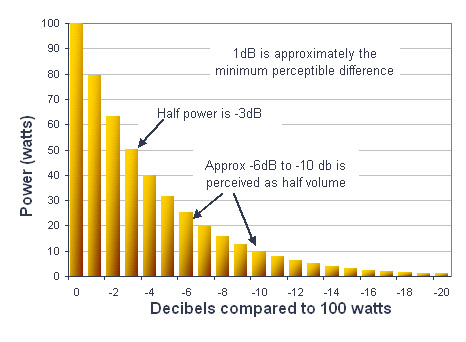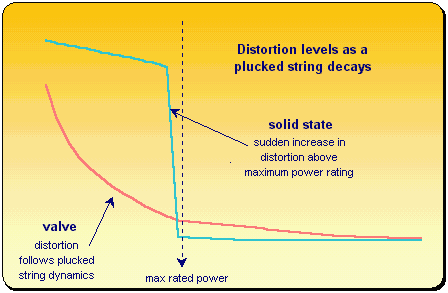Amplifiers - Power & Volume
|
This topic relates to all types of power amplifiers, and talks about power ratings and volume levels.
How Loud Is It?
Before I even talk about power ratings, it's important to understand volume levels. Volume levels are measured in decibels (dB) and these can be either:
- Absolute - usually shown with SPL which means sound pressure level, or
- Relative - compared to another volume level
Speaker systems are usually shown with an absolute measure, like "98dB @ 1 Watt, 1 metre". This is not as complicated as it looks; it means that the speaker produces a sound pressure level (SPL) of 98dB when measured 1 metre away using a 1 watt signal. This is a reasonably accurate way to compare speaker systems.
Some typical sound pressure levels are:
- 60dB - normal conversation
- 120dB - threshold of pain
- 130dB - mugger deterrent
- 200dB - Saturn rocket blastoff
When comparing speakers, or power amplifiers, it is the relative measure that is important.
- 0dB means "no difference", that is, the same volume level
- Decibels less than zero (eg -3dB) mean softer, while decibels more than zero (eg +3dB) means louder
- A 1dB difference is loosely defined as the smallest change in sound level that is noticeable
- An increase somewhere between 6dB and 10dB is perceived by most listeners as "double" the volume
These are highly subjective, meaning that different people will hear this different ways, and "twice as loud" is a much harder thing to guess than something like "twice as high"! Also, guitarists will usually use extra power to drive extra speakers for a wider spread of sound, resulting in a perceived volume increase more than that produced by the additional power alone.
A guitarist will generally need the amplifier to be heard above the band during solos, and to blend with the band for backing, and rhythm playing. In larger performing situations, this would mostly be managed by a sound engineer, but otherwise it simply means that:
- Lead vocals, and solos should be a few dB louder than the combined level of the rest of the band to be clearly audible above the band.
- Backing needs to be around the same level as each of the other instruments
This will not normally be a problem when playing with good musicians, who will also adjust their own levels to make sure your solos can be heard. They should also play with complementary tones and rhythms that do not compete with what you're playing.
| How Power Relates to Volume |
 top top |
OK, now we know about decibels, and that 1dB is roughly the smallest change we can perceive. Have you ever wondered why a 100 Watt amp doesn't sound twice as load as a 50 Watt amp? It's because double the power is equivalent to only a 3dB increase in volume!
This is the same for any power comparison: provided you use the same speakers, and the same amp design (more on that later). 60 watts is 3dB louder than 30 watts, 400 watts is 3dB louder than 200 watts, etc. Likewise, double the volume requires at least a 6dB increase, which is equivalent to 4 times the power!

For those who are interested:
dB difference = 10 x LOG(power1 / power2)
dB difference = 20 x LOG(voltage1 / voltage2)
Bear in mind though, that there are often other factors that make a difference. Playing in a band with an amplifier that is slightly underpowered for the rest of the band is nearly like playing without an amplifier at all. So playing with an amplifier that may be only 3dB louder (double the power) may be just enough to be heard properly, and make all the difference. Also, when playing at low volume levels, your ears hear middle frequencies more efficiently (so you would need to turn up the bass and treble a little to keep the same tone). This in itself makes it hard to compare drastically different power levels.
This is also why speaker efficiency is so important. If one speaker is 3dB less efficient that another (so that's -3dB), it is effectively like using an amplifier with only half the power. Of course, -3dB is "noticably quieter", but not half the volume level.
Here are some very rough guides (and broad generalisations) for typical valve power amplifiers in rock/cover band situations:
- 5 to 15 watts is common for home practice amplifiers
- 30 watts is common for quiet to medium volume rehearsals, recording, and bands that consciously perform at medium levels to allow a full sound mix by an engineer.
- 50 to 60 watts is common for medium to loud levels in small to medium sized venues
- 100 watts is typical for loud bands, loud drummers, and larger venues
Power Ratings
Fortunately, most professional guitar amplifiers are rated in Watts RMS, which allows for a reasonably fair comparison between amplifiers of the same general design. Chances are you've also seen 'ghetto blaster' sound systems in electrical outlets advertised with power ratings like 2000 watts in a plastic case the size of a lunch box! So what gives?
While its not false advertising, it is somewhat misleading by using a measure that is not necessarily typical for all types of music played on the system. But for what it's worth, RMS power is not necessarily representative of the perceived loudness of a guitar amplifier (see below).
Maths alert - arithmetic lies ahead in the next few paragraphs!
There are several different ways to measure power, but firstly, power is a simple electrical calculation. It is voltage multiplied by current (so a 12 volt battery driving a headlight that draws 10 amps of current = 120 watts).
power(watts) = voltage x current(amps)
From Ohm's law, it is the same thing as voltage squared (multiplied by itself) then divided by resistance. So a 10 volt battery driving a 5 ohm load is 10 x 10 / 5 = 20 watts.
power(watts) = voltage x voltage / resistance(ohms)
For our audio guitar signals, though, we're dealing with alternating current (AC) as opposed to DC in batteries. All this means is that the signals fluctuate between a positive and negative value many times per second. Whether a signal is positive or negative at any given time does not matter for power calculations. This is also apparent in the calculation above where voltage is squared: (-10)x(-10)=100 is the same as 10x10=100.

Here are some typical ways to measure AC power:
- RMS (root mean squared) power is a statistical averaging method of the power delivered by a sine wave at some arbitrary low THD (total harmonic distortion) level. "Low distortion" usually means "at the onset of audible clipping". For a sine wave, the voltage is the sine wave's peak voltage divided by the square root of 2 (approx 1.4), and the resistance is the speaker impedance. So an amplifier that gives 14 volts peak (that's 28 volts peak to peak for the positive and negative halves of the sine wave) into an 8 ohm speaker gives a power of: 14 / 1.4 = 10 volts, 10 x 10 = 100, 100 / 8 ohms = 12.5 watts RMS.
- Peak power has been used in the past to give higher power ratings to the same amplifiers. This simply uses the actual peak voltage value in the "voltage squared divided by resistance" calculation. It is not realistic, because this power is delivered for only an instant, and the amplifier could not sustain that power continuously. So in our example above, the peak power would be 14 x 14 / 8 = 24.5 watts (actually, its exactly double the power). Fortunately, this is rarely used now, partly because there's an even better way to cook the books ...
- PMPO (Peak Music Power Output). There's no technical definition I can find for this, but it appears to be marketing speak for: "Let's find any excuse we can to advertise more watts"! So we use the peak power rating mentioned above (a fictional double of the RMS power), usually a stereo system, so double again, then sprinkle the fairy dust. There are suggestions that because some music played on these systems is highly percussive (such as techno), that the system can deliver much more power to handle these peaks for very short times. This multiplies the figure yet again by some arbitrary figure, but more importantly, it's very relevant to guitar amplifiers.
I sincerely hope I never see a PMPO rating on a guitar amp, but we all know that a valve amplifier is noticeably louder than the same power solid state amplifier. How can this be? Using the calculations above, there is perhaps a 3dB difference, which would mean about double the power!
Of course this is not the case, but there are reasons for the perceived difference. Most guitar playing is percussive in nature - there is a strong but brief burst of volume as you strike the string, then the note gradually decays to a lower level.
Valve amplifiers exhibit a smooth transition into and out of overdrive, so for example, a 100 watt amp sounds only a little more distorted when trying to deliver 110 watts. This means that you can drive the amp quite hard with a "musically pleasant" amount of overdrive, that sustains a volume level at the amplifier's maximum power capability. As the note decays, the volume level changes little while the sound gradually cleans up (sometimes referred to as a "warm bloom").
On the other hand, solid state amplifiers are very clean right up to their maximum power output, then virtually switch to very high distortion levels above this point. This is hopeless when trying to play percussive sounds around the maximum power output, because the start of the note (the attack) is very distorted and unmusical, then it suddenly becomes clean as the volume dies (perceived as a lack of sustain). The only way to get a reasonable tone is to turn down and try to operate the amp always below its maximum power capability. Of course, many solid state guitar amplifiers now try to minimise this effect (also so they can be advertised with valve-like qualities).

The combination of these two effects is what causes the difference in perceived volume between solid state and valve designs. But in reality 100 watts is 100 watts, whether its valve, solid state or steam driven!
Below is a table showing noise levels and recommended exposure levels before hearing loss can start to occur.
As you can see at 100db 2hrs is the maximum time while at 110db it drops to 30min
OSHA Daily Permissible Noise Level Exposure
8hrs - 90dB
6hrs - 92dB
4hrs - 95dB
3hrs - 97dB
2hrs - 100dB
1.5hrs - 102dB
1hr - 105dB
.5hr - 110dB
.25hr - 115dB
To give some perspective, listening to a music CD in my car, I found 95db to be a good loud listening level.
Some interesting points to note:
One-third of the total power of a 75-piece orchestra comes from the bass drum.
High frequency sounds of 2-4,000 Hz are the most damaging. The uppermost octave of the piccolo is 2,048-4,096 Hz.
Aging causes gradual hearing loss, mostly in the high frequencies.
Speech reception is not seriously impaired until there is about -30 dB loss; by that time severe damage may have occurred.
Hypertension and various psychological difficulties can be related to noise exposure.
The incidence of hearing loss in classical musicians has been estimated at 4-43%, in rock musicians 13-30%.
Obviously individual hearing is different and the choice of whether to wear hearing protection is up to each individua.
|



